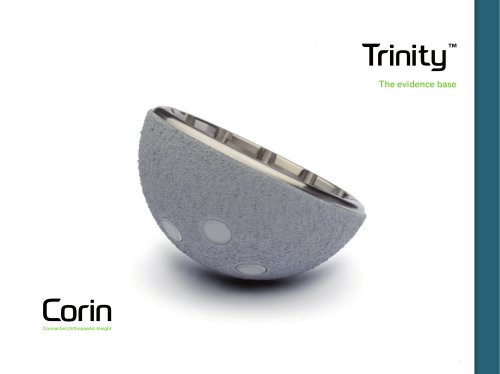 Website:
Corin
Website:
Corin
Excertos do catálogo

Functional safe zone Every patient moves of pelvic rotation through functional activities should be accounted for with total hip replacement. Pelvic tilt been shown to be as great implant. No safe zone has ever accounted for this. OPS™ is designed to optimally orientate a cup within a safe zone, and for the cup to remain within that safe zone as the pelvis rotates throughout functional activity.
Abrir o catálogo na página 2
The arc of pelvic motion has been shown to be as great as 70° through sit to stand activities1 – DiGioia CORR 2006
Abrir o catálogo na página 3
Overview Every patient moves differently1 and their total hip replacement should be optimised to account for this. The orientation of the acetabular cup is one of the most important factors under the surgeon’s control4, and acetabular cup orientation has a significant effect on device performance, including patient outcomes, impingement, edge loading, bearing wear, osteolysis and loosening5,6. There remains two key issues with THR today: 1 What is the target for a that orientation? 1 Implant orientation Clinical issue Safe zones Pelvic tilt There have been various attempts to define a ‘safe...
Abrir o catálogo na página 4
2 Delivery Clinical issue Intra-operative tools It is inherently difficult to position the cup during surgery and achieving a target position is a considerable challenge in THR. It has been shown that up to 50% of surgeries miss the intended orientation13 and the chance of hitting a target to within 5° can be as low as 21.5%14. Clinical solution How is the optimised position delivered during surgery? Once the target orientation for a specific patient has been decided, a unique guide is produced for the individual. The planned orientation is built into the axis of the guide which is used...
Abrir o catálogo na página 5
DiGioia AM, Hafez MA, Jaramaz B, Levison TJ, Moody JE, Functional pelvic orientation measured from lateral standing and sitting radiographs. Clin Orthop Relat Res 453:272–276 Ishida T, Inaba Y, Kobayashi N, Iwamoto N, Yukizawa Y, Choe H, Saito T. Changes in pelvic tilt following total hip arthroplasty. Journal of Orthopaedic Science. 2011; 682-688 Au J, Perriman DM, Neeman TM, Smith PN. Standing or supine x-rays after total hip replacement - when is the safe zone not safe? Hip International. 2014 Echeverri S, Leyvraz P, Zambelli P, et al. Reliable acetabular cup orientation with a new...
Abrir o catálogo na página 6Todos os catálogos e folhetos técnicos Corin
-
MiniHip™ - The evidence base
16 Páginas
-
MiniHip™ - product overview
12 Páginas
-
Trinity™ - surgical technique
16 Páginas
-
Trinity - design rationale
12 Páginas
-
Biomimetic Cementless Technology
12 Páginas
-
ECiMa™
12 Páginas
-
TriFit TS™
12 Páginas
-
Trinity™ - product overview
12 Páginas
-
Optimized Positioning System
12 Páginas
-
Unity knee surgical technique
24 Páginas
-
TriFit TS surgical technique
12 Páginas
-
MiniHip™ - surgical technique
12 Páginas
-
Unity KneeTM
16 Páginas
-
TriFit TS? - technical summary
6 Páginas
-
ECiMa? - vitamin E technology
6 Páginas
-
TriFit TS?
12 Páginas
-
MiniHip - design rationale
16 Páginas
-
MiniHip - product overview
12 Páginas
-
Trinity
12 Páginas





















